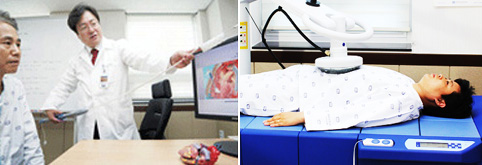
‘Stent Graft Insertion’ procedure has opened a new chapter of aortic aneurysm care
Aortic aneurysm refers to the condition which a part of long cylindrical tube like aorta is disfigured (dilated) as a shape of a bag. Aorta serves as the main passageway of supplying oxygen-rich blood to the entire body as it is directly connected to the heart as well as to the major organs (brain, liver, stomach and small intestine) by blood vessels. The formation of aortic aneurysm on the wall of aorta can be life threatening regardless of its location if the condition of aneurysm worsens over time and is torn.
Once the aorta, the largest blood vessel in the body ruptures, only 50% of patients arrives hospital alive, and the survival rate of the admitted patients after the surgery is less than 50~60%. For Kim (76) who made it to the hospital alive with stable blood pressure despite her old age received stent graft instead of sternotomy without general anesthesia or a chest incision to reduce risks of surgery dramatically.
Stent graft can increase the safely of surgery on elderly patients compared to laparotomy. No matter how well the surgery is done, low resilience of elderly patients increases the chance of complications, and this is why surgical procedure with less and small incision is absolutely preferred especially on elderly patients.
In the past, to remove aortic aneurysm, major operation was required – replacing deformed aorta with artificial vessel through an incision as large as 50~60cm from one’s chest to stomach. Now stent graft is replacing high-risk surgery. Without general anesthesia or a chest incision, a stent ‘mesh tube’ is inserted through a femoral artery in the groin. When the stent reaches the aneurysm site, the sheath is withdrawn leaving the graft in place. The graft then expands against the walls of artery to form a normal healthy shape.
Incheon St. Mary’s Hospital of the Catholic University of Korea has succeeded the surgery without extracorporeal circulation through heart-lung-machine. Performing extracorporeal circulation to temporarily arrest heart before the surgery generally causes complications due to the usage of heart-lung-machine. Thus, eliminating extracorporeal circulation process can reduce recovery period, inflammatory response as well as post surgery complications. Heart-lung-machine is not used on stent graft procedure.
Incheon St. Mary’s Hospital uses the latest stent graft technique successfully on aortic aneurysm cases and even for the complicated cases like aortic aneurysm rupture.